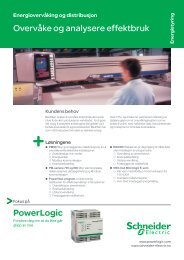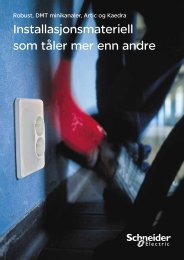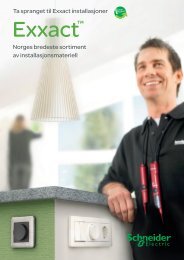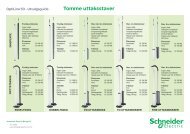Creating Safe Campuses with Integrated ... - Schneider Electric
Creating Safe Campuses with Integrated ... - Schneider Electric
Creating Safe Campuses with Integrated ... - Schneider Electric
You also want an ePaper? Increase the reach of your titles
YUMPU automatically turns print PDFs into web optimized ePapers that Google loves.
SummaryI. Executive Summary...................................................................................... 3II. Campus Security Issues Today.................................................................... 4III. Moving Beyond Basic Security Technology.................................................. 5Intrusion Detection.................................................................................... 5Access Control......................................................................................... 5Video Surveillance Technologies............................................................... 6Video Analytics Help Spot Incidents.......................................................... 7Integrating Intrusion Detection, Access Control, and Video Surveillance..... 8IV. Benefits of Integration................................................................................. 9<strong>Integrated</strong> Security and Lighting Control................................................... 9Convergence: The Future is Here.............................................................10V. Examples of TAC Customer Solutions.........................................................11The Georgia Institute of Technology.........................................................11The University of Wales...........................................................................11VI. Conclusion................................................................................................12
White PaperI. Executive SummaryCampus security and safety are important issues at universities today.Providing students nationwide <strong>with</strong> a safe environment in which to learn,and keeping students, parents and employees well informed about campussecurity are goals that have been voiced by many groups. These goals wereadvanced in 1990 by the Clery Act, which requires all colleges and universitiesthat participate in federal financial aid programs to keep and discloseinformation about crime on and near their respective campuses.Theft on campus, property crime and information security are major concernstoday. Universities invest millions of dollars in security technology <strong>with</strong> theintention of increasing security, protecting students and staff, and solvingsecurity issues. This technology includes burglar alarms, fire protectionsystems, video surveillance, access control systems, and intrusion detectiondevices. Technology, in the hands of competent and capable security officers,can reduce crime, cut material losses, and keep people safe. But keepingsecurity staff trained on separate, stand-alone systems can be challenging,and must be addressed as part of broader campus security objectives.The key systems of security are intrusion detection, access control, and videosurveillance. If each of these systems is purchased separately, administrationand training can burden a university’s resources. Intrusion alarms occur onone system, access badges are administered in a stand-alone database, andintelligent digital video technology runs on dedicated computer equipment.Each system requires service, maintenance, administration, and training.By integrating these separate security systems under a flexible buildingautomation system (BAS), university management realizes a lower upfrontinvestment for a considerably more powerful security solution. Installation andtraining occur on a single system. Operational costs like administration andmaintenance are also reduced. Component devices are used in multiple waysto trigger lighting, video capture, pan-tilt-zoom, higher video resolution orframe rate, door locks, and other aspects of building control. A single systemenables greater flexibility to add security components that can be easilyintegrated into the overall system, keeping the cost of capital expenditures low,and requiring little additional training.An independent study by Strategic ICT Consulting of a 145,000 square footbuilding shows a system installation cost saving of 24% for an integratedBAS versus separate systems. And after installation, operations and life-cyclesavings continue. Project analysis by Teng & Associates shows that trainingis reduced 33%, IT administration is reduced 82%, and the cost for changes,upgrades, and additions to an integrated system are reduced by 32%. Theseoperational figures are based on experience and measurement, and clearlydemonstrate the value of an integrated BAS.Finally, this paper will show several examples where TAC has effectivelyapplied building automation products and related services to provide effectiveintegrated security for its customers.<strong>Creating</strong> <strong>Safe</strong> <strong>Campuses</strong> <strong>with</strong> <strong>Integrated</strong> Security Solutions | 3
White PaperIII. Moving Beyond BasicSecurity TechnologyRegardless of the size of the campus, its locationor the level of security risks that need to beaddressed, there are essential components ofan electronic security system. These includeintrusion detection, access control, and videosurveillance. These three systems, in the handsof competent and capable security staff, applytechnology effectively to reduce crime and protectpeople and property on campus. We will examineeach system individually, and then in combinationsto demonstrate how integrating security intothe building automation system leverages thesesystems in multiple ways, increasing security andreducing operating and training costs.Intrusion detectionSimple intrusion detection is probably the mostfamiliar concept of security to most people. Intrusiondetection involves the use of door or windowcontacts, glass contacts, or motion sensors, incombination <strong>with</strong> some type of audible alarm thatsounds when a person has forced entry into abuilding or room. An alert is sent to the police orsecurity station to notify authorities of the time andlocation of the incident. Security officers respond inperson to evaluate the situation.This method of incident response can be adequatefor detecting an event and quickly getting to thescene. But the effectiveness of the response at thescene and subsequent prosecution is dependenton several things; the proximity of securitypersonnel to the incident; whether witnesseswere present; the number of people involved; theseriousness of the incident, and other factors.Furthermore, <strong>with</strong> simple intrusion detection,there is little in place that would deter people fromcommitting a crime the first place.More information would be helpful, such ascaptured details of the situation that could lead toproper response and identification of perpetrators,thereby reducing the likelihood that a similarincident would occur again. Door and windowcontacts, motion sensors, and other devicesalready in use for alarming can be put to better useto help gather this information by triggering otherparts of the security system.Access controlAccess control is the means by which people aregranted or denied access to restricted areas, suchas residence halls, labs, parking garages, and feefor-serviceareas like cafeterias or laundry. Collegesand universities are unique <strong>with</strong> respect to accesscontrol because the needs of the community varywidely depending on who needs to go where.There are day students, night students, athletes,faculty, staff, and other personnel <strong>with</strong> dissimilarrequirements for security and building access.Some people on campus require varying degreesof temporary access privileges, and others needpermanent access.With so many different needs, how doesmanagement begin to evaluate the many typesof access control systems that are available?Furthermore, in a growing and changing campusenvironment, what is the best kind of accesscontrol to meet future needs?A flexible form of access control uses cards<strong>with</strong> magnetic card readers, proximity readers,barcodes, or smart cards <strong>with</strong> embeddedmicroprocessors. Card access control at collegesand universities is common today, and thereare a variety of systems <strong>with</strong> different levels ofsophistication. There are many advantages tocard access control. Students can be coded<strong>with</strong> access to specific areas depending on theiracademic major, seniority, class enrollment, teamparticipation, or any number of factors. Individualprivileges can expire on a given date if desired.And access can be granted or denied at any timebased on the student’s status. Cards can alsobe used as debit cards for meal-plans and other<strong>Creating</strong> <strong>Safe</strong> <strong>Campuses</strong> <strong>with</strong> <strong>Integrated</strong> Security Solutions | 5
White Paperuniversity fee-based services. In areas wheretighter security is required, management can installkeypads, keypad/card combinations, or biometricdevices that can scan fingerprints or handprints.When used as a stand-alone system, card readersand other electronic access devices offer a costeffectiveand flexible way for a university to controlwho has access to the various parts of campus,<strong>with</strong> the system recording who has gone where,and when. The sequence of operations is for theaccess device to trigger the door lock, entry isgranted, and the event is recorded by the centralsystem. But if a device can trigger the lock, whynot use this inherent ability to trigger other securitydevices as well? As a stand-alone system, accesscontrol does its job, but does not fully leverage theconnected sensors for broader security objectives.Video surveillancetechnologiesVideo surveillance has evolved significantly inthe last decade. Older video systems neededbanks of video tape for continuous recording, andrequired manual administration to swap tapesperiodically during the day. Record keeping wasprone to errors and finding specific incidentson tape was time-consuming. Digital VideoRecorders (DVRs) made significant advances infeatures and functions, taking advantage of fastcomputer processors and high density storagemedia to digitize, compress and record videofrom analog cameras. Newer cameras today haveembedded processors that enable video to becompressed <strong>with</strong>in the device and transmittedreal-time over IP networks to Network VideoRecorders (NVRs) that centrally manage videofeeds from many IP cameras.DVRs and NVRs have many advantages overolder analog recording technology. Streamingvideo can be continuously recorded anddiscarded in cycles of days, weeks, or monthsif no security incidents occur. If an incident doesoccur, disk indexing and time-stamping make itsimple to find video from a given date and time.In addition, because the video is digitized, it canbe exported and distributed via email or backedup on CD, DVD, or other digital media usingcommon computer backup programs that arewidely available.Digital video surveillance is cost-effectiveand sold by many vendors in a highly pricecompetitivemarket. If purchased as a separatesystem to meet the needs of a security planor upgrade, a DVR or NVR may be adequatefor immediate surveillance objectives. But ifthis digital video recorder is integrated <strong>with</strong>an organization’s access control and intrusiondetection system (as part of the broaderbuilding automation system), the user improvessurveillance and reduces the need for additionalsecurity personnel.<strong>Integrated</strong> <strong>with</strong> access control, video verification,for example, allows a user to see live video as wellas the cardholder’s picture when a given accesscard is presented at a reader. The security staffcan verify that the person presenting the badge isthe actual cardholder. Another example of videoverification effectiveness occurs in identifyingindividuals who are “tailgating,” or when oneperson swipes their badge and gains access to thefacility and another person follows them in <strong>with</strong>outpresenting their badge. The integrated systemallows organizations to visually identify, verify andcapture security breaches at access points.<strong>Creating</strong> <strong>Safe</strong> <strong>Campuses</strong> <strong>with</strong> <strong>Integrated</strong> Security Solutions | 6
White PaperVIDEO ANALYTICS HELP SPOT INCIDENTSThe advent of video analytics brings additional flexibilityand increased productivity of security staff who monitormany cameras. Video analytics is a technology applied insoftware that examines the video camera’s field of viewDEO ANALYTICS HELP SPOT INCIDENTSfor patterns of movement that match real-life events,e advent such of video as falling, analytics fence brings climbing, additional lurking, flexibility and trip-lines.Video analytics softwareVideo helpd increased Video productivity analytics provides of security a means staff who by monitor which the user cantracks people or objects,any cameras. focus spot only Video incidentson analytics what is is truly a technology important, applied managingand can alarm on typesof behaviorftware surveillance that examines by the exception video camera’s events field rather of view than all events.r patternsTheofadventmovementof videothatanalyticsmatch real-lifebrings additionalevents,ch as falling, AflexibilityDVR fence orandNVR climbing, increasedcan be lurking, productivityconfigured and of trip-lines. tosecurityonly display adeo analytics camera’s staff who provides monitor video a if means many a specific cameras. by which event Video the or user analytics alarm can occurs. At acus only university is on a technology what is for truly example, applied important, in foot software managing traffic that on examines a sidewalk near arveillance residence the by video exception camera’s hall may events field be of deemed rather view for than normal, patterns all events. and of not trip analarm movement according that match to video real-life analytics events, such assessment. However, Video analytics software tracks people or objects,DVR or NVR falling, can fence be configured climbing, lurking, to only and display trip-lines. aand can alarm on types of behaviorstepping off the sidewalk and crossing left-to-right acrossmera’s video Video if analytics a specific provides event a or means alarm by occurs. which the At athe field of view to a window may trigger an alarm.iversity for example, foot traffic on a sidewalk near aAdditional user can focus alarms only can on what be escalated is truly important, if video analytics sidewalk detect and loitering crossing near left-to-right the window, across the or someone climbing asidence hall may be deemed normal, and not trip anfence. managing surveillance by exception events rather field of view to a window may trigger an alarm.arm according to video analytics assessment. However, Video analytics software tracks people or objects,than all events.Additional and alarms can alarm can be on escalated types of behavior if videoepping off the sidewalk and crossing left-to-right acrossThese are examples of how expanded use of video analytics surveillance detect loitering technology near can the window, increase or security at universitiese field ofAviewDVRtooraNVRwindowcan bemayconfiguredtriggertoanonlyalarm.displaysomeone climbing a fence.ditional<strong>with</strong>outalarmsrequiringcan be escalatedan increaseif videoinanalyticssecurity personnel.detect loitering near the window, or someone climbing aa camera’s video if a specific event or alarmnce.occurs. At a university for example, foot traffic on These are examples of how expanded use ofa sidewalk near a residence hall may be deemed video surveillance technology can increase securityese are examples of how expanded use of video surveillance technology can increase security at universitiesnormal, A university and not trip serving an alarm 20,000 according students to video on five campuses at universities sought <strong>with</strong>out an requiring integrated an increase BAS that in would allo<strong>with</strong>out requiring an increase in security personnel.analytics the school assessment. to decrease However, operating stepping costs, off the increase security security personnel. for students and faculty, and allow forremote monitoring of each campus from a central location. The resulting system controls andmonitors a wide variety of different building functions, such as access control events and logs,A university serving 20,000 students ventilation, A university five campuses serving day and 20,000 sought nighttime students an integrated energy on five campuses use, BAS chillers that sought would and allow boilers, integrated and airthe school to decrease operating costs, quality. BAS that increase Even would security allow though the there for school students are to decrease five and campus operating faculty, locations, and costs, allow increase they for are all centrallyremote monitoring of each campus security from a for central students location. and faculty, The and resulting allow for system remote controls monitoring and of eachmonitoredcampus fromfroma centralan off-campuslocation. The resultingoffice.system controls and monitorsmonitors a wide variety of different building functions, such as access control events and logs,a wide variety of different building functions, such as access control eventsventilation, Aand day serieslogs, and ventilation,of nighttime unobtrusiveday energy andsecuritynighttime use, chillers measuresenergy and use, boilers, arechillersin place and air boilers,that ensureandstudentquality. Even safety air though quality. and Even there prevent though are five campus there campus are crime five locations, campus or unlawful locations, they are trespassing, they all are centrallycentrally <strong>with</strong>outmonitored from an off-campus office.monitored interfering from an off-campus <strong>with</strong> university office. life. Three of the campuses have a state-of-theartA series of unobtrusiveA series contactless of unobtrusive smartcard-basedsecuritysecuritymeasuresmeasures accessare inareplacein control placethatthat systemensureensure thatstudentstudent is linked via theuniversity’s safety and prevent existing campus IT Ethernet.crime or unlawful trespassing, <strong>with</strong>outsafety and prevent interfering campus <strong>with</strong> university crime or life. unlawful Three of trespassing, the campuses <strong>with</strong>outhave a state-of-theartcontactless TAC university system smartcard-based life. controls Three of over the access 160 campuses control doors system have and can a that state-of-the-handle is linked 20,000 via the uniqueinterfering The <strong>with</strong>art contactless university’s smartcard-based existing IT Ethernet.users. The system users. The system also access integrates control <strong>with</strong> system other that security is linked systems, via the such asCCTV and intrusion university’s alarms. TheexistingTAC The system BAS IT Ethernet. controls over all aspects 160 doors of and security can handle 20,000 daily indoor unique users. environmentaloperations via The system users. The system also integrates <strong>with</strong> other security systems,The constant TAC system readings controls from over 3,500 160 control doors and points. can Via handle the 20,000 university unique Ethernet, data passessuch as CCTV and intrusion alarms. The BAS controls all aspects of securityusers. The from system one building users. to The another system and daily and also indoor allows integrates environmental system <strong>with</strong> access other operations from security via any constant systems, site. readings such as from 3,500CCTV and intrusion alarms. The BAS controls points. all Via aspects the university of security Ethernet, and daily data passes indoor from environmentalone building tooperations via constant readings fromanother3,500andcontrolallows systempoints.accessVia thefromuniversityany site.Ethernet, data passesfrom one building to another and allows system access from any site.7CREATING SAFE CAMPUSES WITH INTEGRATED SECURITY SOLUTIONS7EATING SAFE CAMPUSES WITH INTEGRATED SECURITY SOLUTIONS<strong>Creating</strong> <strong>Safe</strong> <strong>Campuses</strong> <strong>with</strong> <strong>Integrated</strong> Security Solutions | 7
White PaperSURVEILLANCEintegrated BAS to provide aIntegrating intrusiondetection, access control,and video surveillancepus, limiting access to facilitiesduce the risk of crime. This isty solution. Using an integratedsurveillance Today’s access cameras, control control and video surveillancers (DVRs). systems When can an work alarm together is in an integrated BAS toing, display provide live a holistic video solution from a on college and universityn administrator campuses. all Keeping at the intruders same off campus,limiting access to facilities that house expensiveequipment, and remotely monitoring secludedareas to reduce the risk of crime. This is why morehen a student contactsand more campuses now rely on CCTV as part ofy the scene to observe thetheir overall security solution. Using an integratedseful for adding extrasystem, security staff at a central monitoring stationially late at night.can view live images from surveillance cameras,control pan-tilt-zoom cameras, or search for videoclips stored on digital video recorders (DVRs).When an alarm is triggered by another part of theBAS, it can command the DVR to begin recording,display live video from a linked camera at thelocation, map the alarm location, and send ane-mail to an administrator all at the same moment.CCTV cameras are an important component ofcampus emergency call boxes. When a studentcontacts security via one of these stations, lightsand cameras can be activated to survey thescene to observe the emergency, and officers canintervene to thwart an attack. Cameras are alsouseful for adding extra protection in remote areas,such as parking lots and garages on campus,especially late at night.dituresoday.stemhistedA major university of medicine on the U.S. east coast has increased expendituresfor security from a $100,000 investment in 1993 to more than $2 milliontoday. One reason for the increase is that the university has upgraded itsCCTV system to digital video recorders <strong>with</strong> Ethernet capability and added 75cameras. This enabled the security staff to record, play and view surveillanceactivity simultaneously <strong>with</strong> digital day/night pan-tilt-zoom cameras stationedthroughout the university’s campuses spread across five cities. The integratedsurveillance and access-control systems allow officials to call up instant live videoand recordings of alarm conditions and system activity. Using a single systemthat ties all of its properties together, the university has improved security whilemaintaining a discrete and unobtrusive surveillance presence for more than18,000 students, researchers, teachers, patients and employees.e system that ties all ofing a discrete anders, teachers, patients8<strong>Creating</strong> <strong>Safe</strong> <strong>Campuses</strong> <strong>with</strong> <strong>Integrated</strong> Security Solutions | 8
White PaperIV. Benefits of IntegrationFor colleges and universities <strong>with</strong> diversepopulations and building types spread over largeareas, integrating various building systems offersnumerous advantages. Foremost, integrationprovides for reduced installation and operatingcosts because it eliminates component redundancyand allows customers to streamline operations.Furthermore, it reduces training and empowerssystem operators by allowing them to perform theirduties more efficiently. Colleges and universitiesare also vulnerable to lawsuits alleging negligencein providing security, especially if there are unevenor inconsistent levels of security for buildings <strong>with</strong>similar purposes or design. Integration allows foruniform monitoring and control across a campusand demonstrates that an institution has appliedappropriate security strategies at all its buildings.Lastly, enhanced safety, security and comfortcreate a more positive learning environment wherefaculty can teach and students can learn.Benefits of Integrating the Security System <strong>with</strong> the BAS• A site-wide single-seat interface enables one person to be trained on multiple security systems.• Security components become multi-use. A motion sensor can be used for lighting control duringoccupied hours, and intrusion detection during unoccupied hours.• During design, flexibility, efficiency, and economy provide room for additional security expansion orintegration at the lowest cost.• Better and more flexible response to campus needs, offering students and staff greater security andpeace of mind.• More information put to effective use, which gives university security staff solid ground to stand on forprosecution and proof of loss. CCTV records also aid law enforcement authorities in finding criminals.• Vendor independence, allowing the university customer to choose among best-of-class securityproducts.• Laundry facilities and kitchens can consume 10-15% of the building’s energy, increasing the need tomore closely monitor hours of peak demand from these sources.• Single-source responsibility, whereby one integrator is held accountable for all the components of thesecurity system.<strong>Integrated</strong> security andlighting controlBy way of example, consider the benefits of simplyinstalling a lighting control system versus integratingit <strong>with</strong> security. In a university laboratory facility, thelighting controls will enable the operator to maintaincomfortable lighting levels and use presets to controlthe lighting. This ensures the lights are only onwhen and where they are needed, saving energyand related costs. If, however, there is a securitybreach late at night, <strong>with</strong>out integration, personnelwill need to locate switches and issue commands tothe control system to switch on lights in the affectedarea. If the lighting controls are integrated, thescenario after the security breach is much different.The lights are automatically switched on in the areawhere the security breach is reported, and CCTVcameras are activated to record the emergency. Theoperator has a single console to assess the situationand to ensure the appropriate reaction from the firedepartment or police.<strong>Creating</strong> <strong>Safe</strong> <strong>Campuses</strong> <strong>with</strong> <strong>Integrated</strong> Security Solutions | 9
White PaperWith an integrated security and BAS, it is possiblefor a university’s facility staff to control entirebuildings from one workstation via a networkedcomputer. From this single browser interface,operators can manage diverse building functions,such as environmental control, access control,video surveillance and alarm and event monitoring.Building staff can view live or recorded video, openor lock a door, grant access to service techniciansfor emergency situations and handle visitormanagement. These tasks can be accomplishedonsite or remotely at any time, whether duringbusiness hours, at nights or on weekends.Integration Improves the Bottom LineIn an independent case study involving a 145,313square-foot office building <strong>with</strong> 1,500 occupants,a research team examined the installation costs ofthe components of a non-integrated BAS versusthat of an integrated BAS.Systems integrated:Lighting ControlsBuilding ControlsSecurityFire and Life <strong>Safe</strong>tyMetering and MonitoringStructured Cabling$2,464,693 non-integrated BAS$1 ,868,166 integrated BAS$596,527 difference = savingsAs the results show, the cost-savings weresignificant – over 24 percent. Findings also showthat an integrated approach offers a broad rangeof commercial and technical benefits, includinga single vendor point of contact, efficient projectmanagement, easier equipment deployment andinvestment protection for future upgrades.Source: Strategic ICT Consulting, April 2005Convergence:the future is hereToday, most colleges and universities have highspeedcomputer networks and sophisticated andsecure IT infrastructure. The campus networksupports administrative servers, Internet access,multimedia file sharing, collaborative onlinecommunities, class registration, and many othercomputing resources. This type of infrastructurepositions the institution to leverage the best thatintegrated BASs have to offer by sharing thecampus-wide network for security and facilitiesmanagement as well.As a single integrated system, security and facilitiesmanagement allows many building functions tobe viewed <strong>with</strong>in a single, common interface.All hardware, even video, alarm and printingequipment, can work seamlessly <strong>with</strong>inits framework. Entering security and facilitydata just once, and having the frameworksynchronize <strong>with</strong> existing hardware and softwareautomatically, is common on many campuses. Anintegrated system reduces the overall hardwareand software requirements. This leads to fewertraining issues, lowers training costs, and allowsstaff to work more efficiently trending buildingperformance and troubleshooting buildingalarms. All of these benefits result in decreasingthe burden on tightly controlled higher educationbudgets, freeing more money to go directly toeducational programs.<strong>Creating</strong> <strong>Safe</strong> <strong>Campuses</strong> <strong>with</strong> <strong>Integrated</strong> Security Solutions | 10
White PaperVIII. ConclusionStudents have high expectations when they select a college or university.They require a quality education and campus experience at a reasonable cost.State-of-the-art facilities, safety and security are of primary concern.In order to meet rising expectations <strong>with</strong>in this cost-sensitive market, collegesand universities must invest wisely in their facilities as a strategic assetto recruit students and attract faculty and staff. Fortunately, new buildingmanagement solutions are able to increase campus security while alsomaximizing energy efficiency and performance. This leads to a reduction inoperating costs and enables resources saved to be reallocated <strong>with</strong>in thebudget to new programs for students.Technology must work effectively as a tool for well-trained security staff. Whenevaluating intrusion detection, card access control, and video surveillancesystems, require that your vendors show how integration of these securityfunctions can increase security and minimize the training and burden tosecurity personnel. Ask that they show how integration <strong>with</strong> the campusbuilding automation system could provide further efficienciesof operations.<strong>Schneider</strong> <strong>Electric</strong>One High Street,North Andover, MA 01845 USATelephone: +1 978 975 9600Fax: +1 978 975 9674www.schneider-electric.com/buildingsAll brand names, trademarks and registered trademarks are the property of their respectiveowners. Information contained <strong>with</strong>in this document is subject to change <strong>with</strong>out notice.On October 1st, 2009, TAC became the Buildings Business of its parent company <strong>Schneider</strong><strong>Electric</strong>. This document reflects the visual identity of <strong>Schneider</strong> <strong>Electric</strong>, however there remainsreferences to TAC as a corporate brand in the body copy. As each document is updated, the bodycopy will be changed to reflect appropriate corporate brand changes.© 2006-2009 <strong>Schneider</strong> <strong>Electric</strong>. All rights reserved.WP-COLLEGESECURITY-A4.BU.N.EN.9.2006.0.00.CCSeptember 2006 sm
















